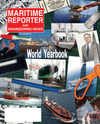
Page 43: of Maritime Reporter Magazine (June 2006)
Annual World Yearbook
Read this page in Pdf, Flash or Html5 edition of June 2006 Maritime Reporter Magazine
June 2006 43 across the industry, but with stark varia- tions between the schedules of different liner carriers. The current percentage of liner vessel calls arriving on time is 57 percent, with 22 percent of all vessels arriving the day after the scheduled day, 7 percent making it two days late and 12 percent of vessels calling at the port of arrival three or more days late.
Looking at individual carriers, their on-time arrival reliability percentages ranged between 0 percent for the least reliable shipping lines and 91 percent for the best performing carriers, over the
December 2005-April 2006 period of the survey (see table, previous page).
Among the major east/west carriers, the lines with the highest schedule relia- bility results are Safmarine, Hatsu
Marine (part of Evergreen) and Maersk
Line, according to the survey. The major east/west carriers with the lowest on- time schedule percentages are
Mediterranean Shipping Co. and China
Shipping Container Lines. "Of the 63 international liner carriers whose vessel schedule reliability we monitor, only 16 have on-time vessel arrivals of 60 percent or more," said
Philip Damas, lead researcher on the
Drewry Container Shipper Insight. "This indicates that a large section of the industry still does not operate with the sort of predictable, reliable schedules which most shippers need," he added.
The low schedule reliability of some carriers can be partly explained by trade-specific conditions, such as port congestion in many African ports.
However, the survey found that, within the same trade route, schedule reliability scores also vary considerably, depend- ing on the individual service and indi- vidual carrier. "In the transpacific trade, regarded as a market where shippers are very demand- ing in terms of fast and reliable transit times, we found that seven West Coast of North America weekly services and three East Coast of North America weekly services had on-time arrivals of less than 30 percent," Damas said.
Drewry contends that most liner carri- ers have not included in their weekly schedules sufficient buffer time for con- tingencies such as bad weather and port delays, and that some lines regard buffer time as too expensive. This was com- pounded in early 2006 by the switch of the vessels of P&O Nedlloyd from the
Grand Alliance to Maersk, which dis- rupted the services of both.
To protect the integrity of their supply chains, Drewry is urging shippers, before they use additional carriers or import from new sourcing areas, to con- sider the schedule reliability levels of different carriers and the varying levels of delays of the trade route concerned.
Quantified trade route and carrier-spe- cific schedule reliability information was not publicly available until now.
According to Drewry's survey, the fol- lowing routes experience some of the highest vessel schedule reliability: transpacific, Asia/Indian
Subcontinent/Middle East, North
America mainland/Hawaii/Guam and, somewhat unexpectedly the South
American East and West Coasts trades to and from both Europe and North
America. The routes with the lowest percentage of on-time vessel arrivals (less than 40%) include: Europe/Africa,
North America/Africa and
Europe/Caribbean/Central America.
Transit time delays of up to four days are typical on some trade routes. (Source: Drewry Shipping
Consultants Ltd., www.drewry.co.uk) “ TO FIND THE FINEST
OCEANGOING VESSELS,
SOMETIMES IT’ S BEST
TO HEAD UPSTREAM.” - Duff Hughes, President, The Vane Brothers Company
Jeffboat, strategically located on the Ohio River in Jeffersonville, Indiana, has been designing and constructing vessels for 67 years. Over 10,000 vessels to be exact, all created with heavier welds, wheelabrated steel and superior coatings. At Jeffboat, not only do you get a technologically advanced oceangoing vessel at reasonable labor cost, you also get a dedicated project team. So when you look to build an oceangoing vessel, just look to the Ohio.
Circle 251 on Reader Service Card 2006WorldYearbook2006WorldYearbook2006WorldYearbook2006WorldY
MR JUNE2006 #6 (41-48).qxd 6/2/2006 11:51 AM Page 43

 42
42

 44
44
